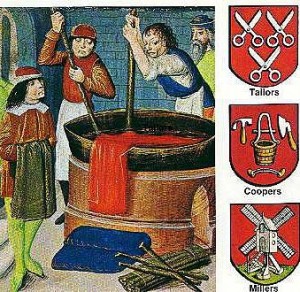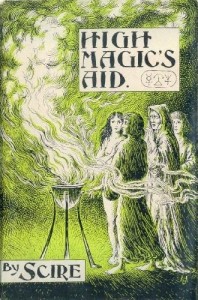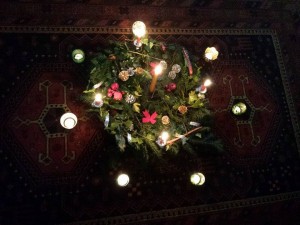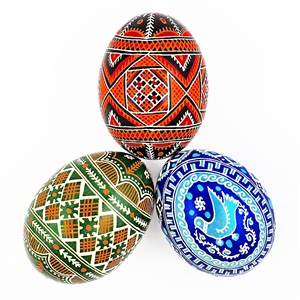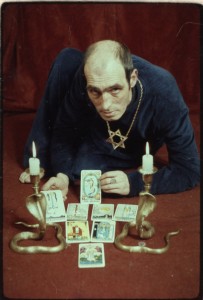Introduction
Within British Traditional Wicca (called in Britain simply “Initiatory Wicca”), there exists a structure known as the degree system. One’s first degree is initiation, or becoming one of the Wicca. Second and third degree initiates are acknowledged to be more experienced initiates of progressively greater skill, talent, or “power.”
But what does it all mean in practice? In order to answer this question, let’s discuss the parallels that the medieval guild structure has with the Wiccan degree system.
A guild was an association of artisans who controlled the practice of their craft in a particular town. A few guilds in France even gave rise to the earliest of the universities, where our modern academic degrees—bachelor’s, master’s, doctorate—retain this guild-like structure: apprentice, journeyman, master.
For those not conversant with matters medieval, here is a brief description of the guild structure.
Apprentices lived with their master while being taught the craft; parents paid for the apprenticeship. An apprentice did not marry until apprenticeship was over, and in return the master guildsman taught well. At the conclusion of apprenticeship, the youth became a journeyman, who had fully learned his trade but was not yet a master. He now earned a wage and was expected to save enough money to start up his own business. For the journeyman to become a master, he had to submit a master work piece to a guild for judgment. If the work were deemed worthy, the journeyman would be admitted to the guild as a master.[1]
However, an extremely significant difference exists between the craft guild system and the Craft or Wiccan degree system. That difference is simple—there is no requirement for any initiate to seek elevation to a higher degree.
In the trade guilds, apprentices are expected to complete training in trade skills and rise to journeyman status as an employable worker in that trade. Mastery is not a guaranteed status, for that requires a certain aptitude or talent beyond the skills, whereas apprentices become journeymen or “flunk out.” In contrast, in the Craft an initiate may continue at first degree without seeking to achieve a higher degree, as they choose. Initiates may, equally, choose to seek elevation as they grow in their Craft and in their life.
Let me state clearly, here, that one must seek out training, initiation, or elevation in British Traditional Wicca. One must ask, or one does not receive; the Wicca do not proselytize. At the same time, asking does not guarantee that any candidate will be accepted for training with a coven’s outer court, initiated into a coven, or elevated to a higher degree. Receiving a yes or no answer from one coven may not be the final answer—but no is a valid answer. Coven leaders make their decisions for the good of their Craft and their coven. Often, no means “not now” or “not with these elders” or “I don’t know why, but my spidey-sense says not him, or not for us.”
Apprentice
Historically, an apprentice was contractually bound for a set period of time (usually seven years) to serve a master at a trade or craft—weaving, metal-smithing, carpentry, stone-working, etc. The apprentice’s duties were often simple labor at the outset, cleaning the shop and learning the most basic activities by observation and instruction: the names and uses of the tools of the trade; the materials used and how they were acquired, stored, readied, and put to use; and the social interactions of the shop, between customer and master, or master and workers, which might include lesser masters, journeymen, and other apprentices.
The duties of an apprentice were to learn his trade in all its aspects, and to keep the secrets of that trade. The master committed in his turn to train the apprentice in the specific trade—the obverse side of the contractual coin. The master provided instruction at the level needed and opportunities to learn by doing. He also corrected the inevitable errors of a novice and remedied the difficulties encountered in novice projects.[2]
The first degree
In British Traditional Wicca, one’s “apprenticeship” begins with initiation. At the time of Gerald Gardner’s initiation in 1939, witchcraft was illegal in Britain. As described by Gerald Gardner, it was only during his actual initiation that he even discovered that the coven initiating him were witches. “I was half-initiated before the word ‘Wica’ which they used hit me like a thunderbolt, and I knew where I was, and that the Old Religion still existed.”[3]
Gardner’s initiation was when he began to learn the Craft specifically. His long interest in matters magical and occult informed his witchy education, but it was not until he was a sworn “brother of the Art Magical” that any information was shared—be it written or oral or action. Like the apprentice of old, Gardner was oath-bound to keep the secrets of the Wicca.
In Gardner’s published non-fiction, he states that he may not describe the magical techniques and words that the Wicca use in their rites; he is keeping his oath of secrecy. For this reason, when writing his 1949 novel High Magic’s Aid, he instead used material from the 19th century McGregor-Mathers English translation of The Key of Solomon (a Latin grimoire of ceremonial magic) to flesh out the scenes that depicted magical workings (spells).
Our rites are transformative, productive of subtle change in those who undergo them. Any new initiate is exposed to words and actions and energies within the magical circle that are outside of prior experience.[4]
It is often said that one’s first degree is especially about getting to know the Goddess, a reality necessitated by the patriarchal roots of modern culture, one in which the very title Pope means “father.” Like the apprentice, a new initiate has duties which are, primarily, to learn: to know the Wiccan calendar, to call a quarter, to structure a ritual, to memorize an esbat ritual, to cast a circle, etc.
Our solar-calendared rituals follow what is now called “the Wheel of the Year” in a neat progression of eight sabbats at the solstices and equinoxes alternating with the cross-quarters that begins at Hallowe’en.[5] Hallowe’en, Candlemas, May Eve, Lammas, these are the fire festivals central to the Wicca. One sabbat ritual at a specific season is a scant introduction to that sabbat’s energies as well as its traditional ritual.
Think about it. You may remember one special Yuletide, but it is more likely that, for instance, you think of youthful summer camps or Mardi Gras events as a collective montage that is seasonal in nature and features a number of actions and feelings that mean that time of year to you. So it is with our sabbats. Doing them more than once takes more than one year.
(Yule, Morgana, 2014)
For this reason, the lunar esbat rituals become familiar to the new initiate much more quickly. Celebrated once or twice monthly at full and new moons, frequent repetition aids both the memorization expected of initiates and aids them to perform the energetic steps that occur in creating, working, interacting with deities, and concluding any ritual circle. By the time initiates have completed a year working in coven, they have experienced at least twelve esbat rituals as well as the four fire festivals, and more likely all eight of the currently practiced sabbats.[6] They will have memorized the esbat ritual text and actions used in coven, and the annual progression of the sabbats have taught the basics of the Wiccan progression of seasons and energies. An experienced first-degree initiate can call a quarter, or all four, perform a simple traditional circle solo if required, work with an experienced partner to lead a pre-arranged esbat or sabbat within the coven, and aid in the general running of the coven. Energetically, the initiate will raise and ground energy as led by the coven leaders or elders.
If the initiate is working towards a hoped-for elevation to the second degree, the necessary first degree material has been completely hand-copied into the initiate’s own book of shadows. Likely the initiate has pursued individual own study interests in support of the coven or personal practice. Within a particular coven’s practice, the initiate may be assigned reading, writing, or practical exercises to complete as a part of training. Thus, sometime following that oft-quoted “year and a day,”[7] a first-degree initiate may be elevated to the second degree.
Journeyman
Journeymen artisans were expected to do just that, journey. Travel from town to town, work with others of the same guild in which they had apprenticed, learn and share styles, materials, tools, and techniques. Like apprenticeship, a journeyman’s study could take years. Journeymen were paid a wage, might live apart from the master’s residence, often married and started a family.
To transition to mastery, journeymen undertook to create a master-piece, a piece of work by their hands that was adjudged to be work worthy of a guild master. And not every journeyman, sometimes called a “jack,” succeeded in becoming a master in his guild. “Jack of all trades and master of none” refers to a person unsuccessful in achieving master status. A competent journeyman often remained in his master’s business as a valued assistant and still might rise to mastery in time. In larger craft workshops, a number of masters might work in a common facility.[8]
The second degree
Whether an initiate has been once or thrice round the Wheel of the Year and its sabbat cycle, elevation to the second degree brings many responsibilities and connections. First and foremost, second-degree elevation connects an initiate to the current of energy specific to initiatory Wicca. Such connection causes inevitable changes in an initiate—ones that need to be absorbed throughout her ensuing year and a day. The second degree carries a responsibility to the Craft as a whole.
The expectations for a newly elevated second-degree witch begin with getting to know the God, a task which often involves path-workings and underworld trance journeys.
Once the degree has settled, the second may guest with other covens, or attend multi-tradition open sabbats or classes of other traditions of witchcraft. During second degree work, initiates explore within themselves as well as without. Often second-degree initiates find challenges in dealing with their shadow selves, those parts which they’d rather not acknowledge, confront, resolve, nor have others know.
The duties of a second-degree witch include learning to teach magical skills, assisting the leaders of the coven, and learning the process of initiation to first or second degree.[9] The teaching requirement of second degree does not send our initiates out in search of converts; the Wicca do not proselytize. A second-degree initiate may have personal or family knowledge that interests the coven. For example, a student of eastern European ancestry might give the coven a class on traditional techniques and designs for dying pysanky, Slavic Easter eggs. Another may pursue research into home-brewing methods for making ritual ales or wines or meads, and share successful recipes in ritual. A working geologist may introduce the group to practical uses of natural minerals, including how to find the crystal that works—in contrast to the one that just looks pretty.
A second-degree practitioner may be given responsibilities beyond that of every coven member. A woman might be named “maiden” of the coven, often considered a deputy high priestess. Similarly, a man might be appointed “guardian” or “summoner” or asked to understudy the role of the high priest. Such understudy roles match the custom of the “maiden coven,” where its coven leaders are second-degree initiates growing into fully-fledged coven leaders under the guidance of their parent coven.
Underworld journeying, shamanic studies, divinatory methods beyond any yet used, Craft history, the second degree calls the witch to live the Wiccan path as much as study it. Inevitably, bumps and bruises, missteps and mistakes occur along the way. Often, coven leaders are called upon to assist with mistakes, correct missteps, cluck over the bumps, and salve the bruises… or not, as seems good to them. Sometimes a coven leader’s hardest task is to allow the error to occur, and wait until asked for assistance before deciding whether to act or to let be, to speak or to keep silent.
During second-degree studies, practitioners determine or discover any Craft specialties. They may have healing talent, and learn ways to use it within Craft as well as without. They may find they develop undiscovered psychic skills, or even the ability to teach them. A second-degree witch may choose a wider audience, presenting open rituals for the local pagan community, offering classes in herbs, stones, divination, or dance. Nothing in the tradition forbids such public teaching, and nothing in the tradition demands it.
Second degree also requires practitioners to step out of their comfort zone, another form of journeying. They may be adept at tarot but ignorant of astrology, talented at rhymed spells but unable to keep a steady beat on drum or rattle. Learning unfamiliar skills, stretching into tasks and techniques that are unfamiliar or outright alien, these challenges broaden practitioners while adding more tools to their witchy toolbox.
Unlike the first degree, once one has progressed to the second degree, one is expected to work to achieve the third degree. First degrees are practitioners, plain and simple, with but responsibility to their gods, their coven, and themselves. Second degree engenders a deeper change, imbuing a sense of having begun something which is less than complete… and an awareness of challenges to come.
Master
In the guild system, once a panel of masters in one’s own guild adjudged one’s submitted master work piece(s) as being of the standard expected of a master in that guild, then one became a master. To give an example, journeymen knitters in one 14th century European guild presented three items to be judged of master-work quality: a man’s shirt, a hat, and a carpet.
(Alex Sanders with Tarot cards)
The third degree
One’s training in any degree truly begins when the ritual initiating or elevating one to that degree is complete.[10] Thus, Gerald Gardner was taught the secrets of the Craft only after his initiation. Similarly, once a candidate is brought to second or third degree, a period of further learning follows, no matter how well-prepared and how apt the candidate may be. At the same time, every BTW coven is autonomous—independent, a law unto itself. This autonomy means that the newly minted third degree witch—theoretically—springs forth fully formed with lore and wisdom at the ready. In practice, any new coven leader consults with her mentors while “finding her feet.”
Once the ritual that creates a third-degree witch is complete, that witch may move into leadership of her coven. She may remain in a supportive role to her coven leaders; for instance, she may be especially skilled in a magical ability, and talented in the teaching of it. In the mobile population and fluctuating job market of our modern society, she may find herself relocated from a region thick with BTW covens to one with but one or two across three states… or none. In such a case, any third-degree witch can found a coven from scratch, a time-consuming labor of love. Equally, she may simply work as “a witch alone” for a time.
By the same token, a witch may be head of the only BTW coven—as far as anyone knows—within several hundred miles, or encounter life-altering circumstances that put her in the midst of a metropolitan region where every second coven among a baker’s dozen is BTW. She might choose, in such a case, to join an existing coven… or even an elder’s coven, a rarity that occasionally blossoms.
All Wiccan covens are led by a third-degree priestess,[11] called in BTW the High Priestess, and assisted by the priest of her choosing, usually also third degree, the High Priest. As with guilds and mastery, achieving the third degree moves a witch into some kind of a leadership role. Because covens are led by thirds, a new third-degree witch may step in to lead an existing coven, or “hive off” from the parent coven to form a new one.
Some of the lore and practice of the higher degrees are unsuited to less-experienced witches. For this reason, written, oral, and ritual practices are usually passed by coven leaders to first, second, and third degrees separately, most often individually. For example, a new initiate may never have experienced the intense combination of spiritual and physical energies that often occur during a magical working in coven. Thus, coven leaders must ensure that when initiates do encounter such, they recover successfully with any needed assistance. Further, coven leaders teach their initiates how to recognize and care for their own needs if working magic alone, as well as in coven, a common practice for many witches.
Any elder may choose to share written, oral, and ritual practice with any initiate as it seems needed, so that a first-degree or second-degree coven member might come to have some lore and material usually restricted to a third-degree witch. In an example of my knowledge, when a witch’s sister was stalked and assaulted with emotional wounds to the entire family, that witch consulted her coven leaders.
Those coven leaders chose to summon arcane aid to back up the mundane legal actions already taken—a restraining order, police charges filed, action for damages, and so on. In an arcane echo of these mundane actions, the coven leaders led a degree-specific circle of the second and third degree members of their coven, which then “bound” and “banished” the perpetrator from doing further injury. And so did that witch come to have written and oral lore—at second degree—which was usually reserved to the third degree.
Conclusion
Such is one of many duties of leadership, to ensure both the continuation and safe practice of our Craft, just as the master in a guild workshop both taught and oversaw safe practice of his craft. The Wicca do not proselytize; however, our elders find that a fair number of individuals seek out the Wicca hoping to learn magic, join a coven, work love spells, gain power, break hexes, acquire status, and so on.
A very few of those seekers discover that the more they learn about British Traditional Wicca, the greater the sense of coming home, of returning to a spirituality and deities they never knew they missed. And some of us find the teachers who “fit” for us happen to be of the Wicca… which is how my own journey into the Craft grew from chance meetings into my own initiation, and thence to hiving off and founding my own coven. A saying among us encapsulates this progression: “May the Gods preserve the Craft!”
[1] http://www.a-london-tourist-guide.com/medieval-guilds.html
[2] Apprenticeships often included fostering; apprentices were housed and fed and clothed by their contracted master, living as a part of his extended family. I do not discuss this aspect of the master-apprentice relationship here, except to note that it existed—its relevance to Wicca is that a coven leader’s role often seems quasi-parental.
[3] The Meaning of Witchcraft, Gerald B. Gardner, 1959
[4] Wicca is often called an experiential religion for this reason—it is not about believing, it’s about doing, experiencing, and dealing with the result.
[5] Historically, the four cross-quarter sabbats or “fire festivals” of Candlemas, Beltane, Lammas, and Samhain or Hallowmas were the Wiccan large events; the solstices & equinoxes were celebrated at the closest full moon circle or esbat. A particularly successful Yule ritual in the late 1950s in Gardner’s coven led to the coven asking to celebrate the solar quarters as separate sabbats.
[6] For simplicity’s sake, I write as though no one ever catches the flu or has an auto accident or a close relative die.
[7] The phrase “a year and a day” describes one full year counted inclusively‚ a term used in mathematics but most often applied to the calendar. Example: one full week, counted inclusively, is 8 days Sunday through Sunday. The same effect arises in music, where an octave (meaning eight) higher is seven half-tones up from the original pitch.
[8] http://en.wikipedia.org/wiki/Journeyman
[9] At second degree, most North American initiates have the ability—but not the authority—to initiate another person into the Wicca; that authority remains with the third-degree coven leaders, who may appoint a working pair of second degrees to lead what is sometimes called a maiden coven. Initiations into such a maiden coven are performed by the second-degree leaders… whose authority to perform the initiations are granted by their elder third degrees. In contrast, some European BTW covens are led by second-degree initiates; the third degree being viewed as almost a spiritual retirement, or one undertaken by a working partnership together to complete the hieros gamos.
[10] Between the two largest segments of initiatory Wicca, Gardnerian and Alexandrian, it has been said that Gardnerians initiate and then train to that level, different from Alexandrians, who train to a level and then initiate to match. These two methods represent the ends of a spectrum along which any coven may operate—if true in practice at one time, that practice has altered in most locations.
[11] In the commonest North American practice, many third-degree witches are coven leaders. In other parts of the world, both second and third-degree witches are coven leaders, and as noted before, British and European covens are often led by second-degree practitioners. In either system, third-degree coven leaders become autonomous and independent.
Other references:
Yule photo, Morgana 2014
Photo Alex Sanders with Tarot cards
This article originally appeared in Patheos, under the title:
Degrees, Guilds, and Initiation Into the Wicca,
November 4, 2014
Published with permission by Deb Snavely.

